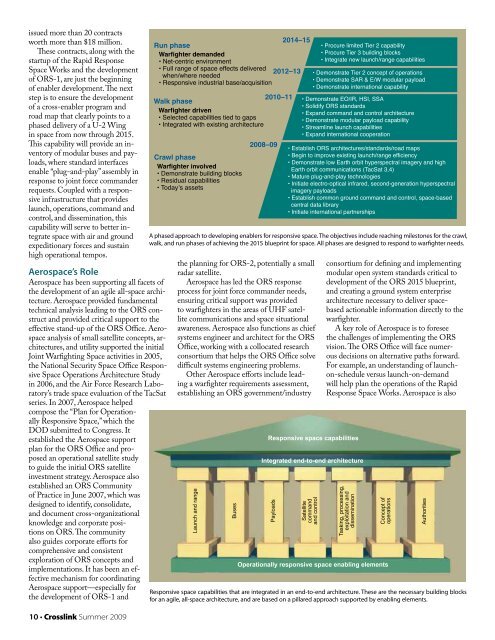Developing Responsive and Agile Space Systems - Space-Library
Developing Responsive and Agile Space Systems - Space-Library
Developing Responsive and Agile Space Systems - Space-Library
Create successful ePaper yourself
Turn your PDF publications into a flip-book with our unique Google optimized e-Paper software.
issued more than 20 contracts<br />
worth more than $18 million.<br />
These contracts, along with the<br />
startup of the Rapid Response<br />
<strong>Space</strong> Works <strong>and</strong> the development<br />
of ORS-1, are just the beginning<br />
of enabler development. The next<br />
step is to ensure the development<br />
of a cross-enabler program <strong>and</strong><br />
road map that clearly points to a<br />
phased delivery of a U-2 Wing<br />
in space from now through 2015.<br />
This capability will provide an inventory<br />
of modular buses <strong>and</strong> payloads,<br />
where st<strong>and</strong>ard interfaces<br />
enable “plug-<strong>and</strong>-play” assembly in<br />
response to joint force comm<strong>and</strong>er<br />
requests. Coupled with a responsive<br />
infrastructure that provides<br />
launch, operations, comm<strong>and</strong> <strong>and</strong><br />
control, <strong>and</strong> dissemination, this<br />
capability will serve to better integrate<br />
space with air <strong>and</strong> ground<br />
expeditionary forces <strong>and</strong> sustain<br />
high operational tempos.<br />
Aerospace’s Role<br />
Aerospace has been supporting all facets of<br />
the development of an agile all-space architecture.<br />
Aerospace provided fundamental<br />
technical analysis leading to the ORS construct<br />
<strong>and</strong> provided critical support to the<br />
effective st<strong>and</strong>-up of the ORS Office. Aerospace<br />
analysis of small satellite concepts, architectures,<br />
<strong>and</strong> utility supported the initial<br />
Joint Warfighting <strong>Space</strong> activities in 2005,<br />
the National Security <strong>Space</strong> Office <strong>Responsive</strong><br />
<strong>Space</strong> Operations Architecture Study<br />
in 2006, <strong>and</strong> the Air Force Research Laboratory’s<br />
trade space evaluation of the TacSat<br />
series. In 2007, Aerospace helped<br />
compose the “Plan for Operationally<br />
<strong>Responsive</strong> <strong>Space</strong>,” which the<br />
DOD submitted to Congress. It<br />
established the Aerospace support<br />
plan for the ORS Office <strong>and</strong> proposed<br />
an operational satellite study<br />
to guide the initial ORS satellite<br />
investment strategy. Aerospace also<br />
established an ORS Community<br />
of Practice in June 2007, which was<br />
designed to identify, consolidate,<br />
<strong>and</strong> document cross-organizational<br />
knowledge <strong>and</strong> corporate positions<br />
on ORS. The community<br />
also guides corporate efforts for<br />
comprehensive <strong>and</strong> consistent<br />
exploration of ORS concepts <strong>and</strong><br />
implementations. It has been an effective<br />
mechanism for coordinating<br />
Aerospace support—especially for<br />
the development of ORS-1 <strong>and</strong><br />
10 • Crosslink Summer 2009<br />
Run phase<br />
Warfighter dem<strong>and</strong>ed<br />
• Net-centric environment<br />
• Full range of space effects delivered<br />
2012–13<br />
when/where needed<br />
• <strong>Responsive</strong> industrial base/acquisition<br />
2010–11<br />
Walk phase<br />
Warfighter driven<br />
• Selected capabilities tied to gaps<br />
• Integrated with existing architecture<br />
Crawl phase<br />
Warfighter involved<br />
• Demonstrate building blocks<br />
• Residual capabilities<br />
• Today’s assets<br />
the planning for ORS-2, potentially a small<br />
radar satellite.<br />
Aerospace has led the ORS response<br />
process for joint force comm<strong>and</strong>er needs,<br />
ensuring critical support was provided<br />
to warfighters in the areas of UHF satellite<br />
communications <strong>and</strong> space situational<br />
awareness. Aerospace also functions as chief<br />
systems engineer <strong>and</strong> architect for the ORS<br />
Office, working with a collocated research<br />
consortium that helps the ORS Office solve<br />
difficult systems engineering problems.<br />
Other Aerospace efforts include leading<br />
a warfighter requirements assessment,<br />
establishing an ORS government/industry<br />
Launch <strong>and</strong> range<br />
Buses<br />
2008–09<br />
<strong>Responsive</strong> space capabilities<br />
Integrated end-to-end architecture<br />
Payloads<br />
2014–15<br />
Satellite<br />
comm<strong>and</strong><br />
<strong>and</strong> control<br />
• Procure limited Tier 2 capability<br />
• Procure Tier 3 building blocks<br />
• Integrate new launch/range capabilities<br />
• Demonstrate Tier 2 concept of operations<br />
• Demonstrate SAR & E/W modular payload<br />
• Demonstrate international capability<br />
• Demonstrate EO/IR, HSI, SSA<br />
• Solidify ORS st<strong>and</strong>ards<br />
• Exp<strong>and</strong> comm<strong>and</strong> <strong>and</strong> control architecture<br />
• Demonstrate modular payload capability<br />
• Streamline launch capabilities<br />
• Exp<strong>and</strong> international cooperation<br />
• Establish ORS architectures/st<strong>and</strong>ards/road maps<br />
• Begin to improve existing launch/range efficiency<br />
• Demonstrate low Earth orbit hyperspectral imagery <strong>and</strong> high<br />
Earth orbit communications (TacSat 3,4)<br />
• Mature plug-<strong>and</strong>-play technologies<br />
• Initiate electro-optical infrared, second-generation hyperspectral<br />
imagery payloads<br />
• Establish common ground comm<strong>and</strong> <strong>and</strong> control, space-based<br />
central data library<br />
• Initiate international partnerships<br />
A phased approach to developing enablers for responsive space. The objectives include reaching milestones for the crawl,<br />
walk, <strong>and</strong> run phases of achieving the 2015 blueprint for space. All phases are designed to respond to warfighter needs.<br />
Operationally responsive space enabling elements<br />
consortium for defining <strong>and</strong> implementing<br />
modular open system st<strong>and</strong>ards critical to<br />
development of the ORS 2015 blueprint,<br />
<strong>and</strong> creating a ground system enterprise<br />
architecture necessary to deliver spacebased<br />
actionable information directly to the<br />
warfighter.<br />
A key role of Aerospace is to foresee<br />
the challenges of implementing the ORS<br />
vision. The ORS Office will face numerous<br />
decisions on alternative paths forward.<br />
For example, an underst<strong>and</strong>ing of launchon-schedule<br />
versus launch-on-dem<strong>and</strong><br />
will help plan the operations of the Rapid<br />
Response <strong>Space</strong> Works. Aerospace is also<br />
Tasking, processing,<br />
exploitation <strong>and</strong><br />
dissemination<br />
<strong>Responsive</strong> space capabilities that are integrated in an end-to-end architecture. These are the necessary building blocks<br />
for an agile, all-space architecture, <strong>and</strong> are based on a pillared approach supported by enabling elements.<br />
Concept of<br />
operations<br />
Authorities

















